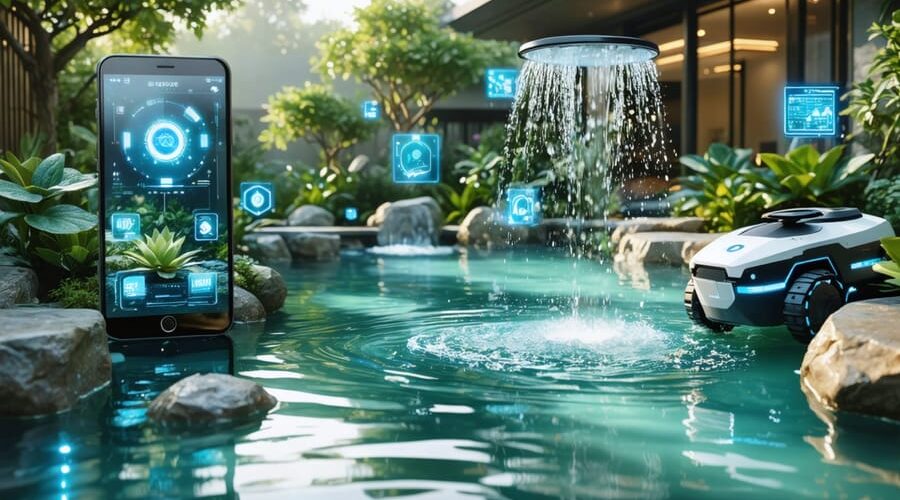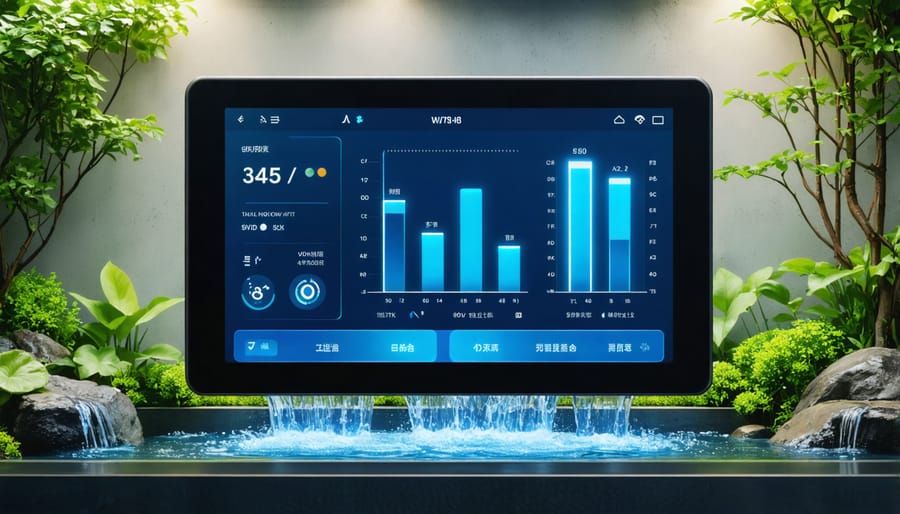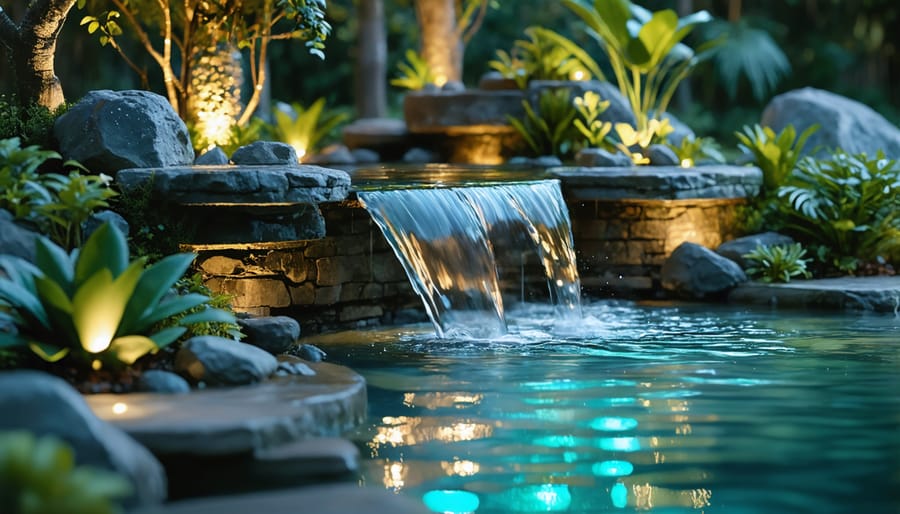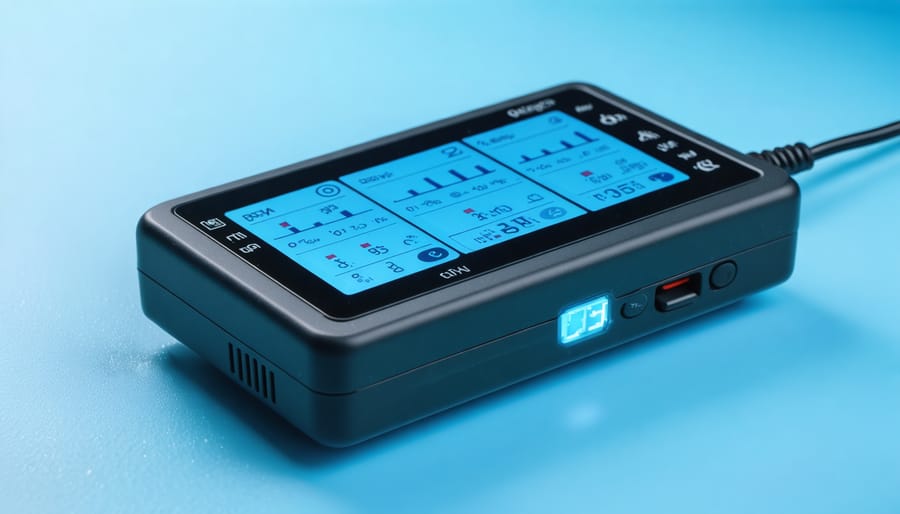
Smart Tech Transforms Your Water Garden Into a Backyard Paradise
Transform your garden into a modern oasis with smart irrigation controllers that automatically adjust watering schedules based on real-time weather data and soil moisture levels. Today’s gardening technology combines centuries-old growing wisdom with cutting-edge innovations, enabling even novice gardeners to achieve professional results.
From automated plant monitoring systems that alert you when nutrients are low to robotic lawn mowers that maintain perfect turf while you relax, modern garden tech saves time, conserves resources, and optimizes plant health. Smart sensors now track everything from soil pH to sunlight exposure, delivering precise data to your smartphone and adjusting care routines automatically.
The fusion of traditional gardening with smart technology isn’t just about convenience – it’s revolutionizing how we grow and maintain our outdoor spaces. Whether you’re a busy professional managing a small herb garden or an enthusiastic horticulturist overseeing a complex landscape, these technological tools make it possible to achieve better results with less hands-on effort. As we explore the latest innovations in garden tech, you’ll discover how to create a more efficient, sustainable, and enjoyable gardening experience that fits seamlessly into your modern lifestyle.

Smart Water Management Systems
Automated Water Level Controls
Keeping your water features at the perfect level has never been easier, thanks to modern automated water level controls. These smart systems are a game-changer for anyone interested in water-efficient garden design and hassle-free maintenance.
The heart of these systems is the electronic water level sensor, which constantly monitors your pond or water feature’s level. When the water drops below a preset point, the sensor triggers an automatic fill valve to replenish it. This means no more manual checking or emergency top-ups, even during hot summer days.
Most modern systems come with additional safety features, like overflow protection and leak detection. Some even connect to your smartphone, sending alerts when water levels change unexpectedly or maintenance is needed. Installation is typically straightforward – you’ll need a sensor, control unit, fill valve, and water supply connection.
For those worried about cost, these systems quickly pay for themselves by preventing pump damage from low water levels and reducing water waste from overflows. They’re particularly valuable for vacation homes or busy gardeners who can’t check their water features daily.
Consider starting with a basic automated system and upgrading as needed. Many users find that the peace of mind alone is worth the investment, knowing their water features are maintaining optimal levels around the clock.
Smart Filtration Solutions
Smart filtration has revolutionized how we maintain our garden ponds and water features. Gone are the days of manually checking water quality and adjusting filtration settings. Today’s intelligent systems do the heavy lifting for us, ensuring crystal-clear water with minimal effort.
Modern filtration solutions come equipped with sensors that continuously monitor water parameters like pH levels, temperature, and clarity. These smart systems can automatically adjust filtration intensity based on real-time readings, preventing issues before they become visible problems. For example, if the system detects an increase in organic matter, it’ll boost filtration power automatically.
What’s really exciting is the integration with smartphone apps. You can now check your pond’s health from anywhere, receive maintenance alerts, and even adjust settings remotely. Many systems offer customizable scheduling options, allowing you to increase filtration during high-use periods or reduce it during cooler months to save energy.
For beginners, smart filtration systems typically come with preset modes that take the guesswork out of maintenance. More advanced users can fine-tune settings to match their specific needs. Some systems even learn from your pond’s patterns over time, creating increasingly efficient filtration cycles.
The best part? These systems are surprisingly energy-efficient. Many use variable-speed pumps that adjust their power consumption based on actual needs rather than running at full capacity all the time. This means cleaner water and lower electricity bills – a win-win for any garden enthusiast.
Lighting and Ambiance Control
Programmable LED Systems
Modern smart outdoor lighting has revolutionized how we illuminate our gardens, offering incredible flexibility and creative possibilities. LED systems now come with user-friendly apps that let you control everything from your smartphone, making it easier than ever to create the perfect ambiance for your outdoor space.
These programmable LED systems offer a rainbow of color options, allowing you to match your lighting to different seasons or special occasions. Want warm whites for a cozy dinner party? Or perhaps blue and purple hues to highlight your water feature? It’s all possible with just a few taps on your phone.
Many systems now include features like scheduling, dimming, and even music synchronization. You can set your lights to automatically turn on at sunset and off at sunrise, or create dynamic light shows that pulse with your favorite tunes during outdoor gatherings.
What’s particularly exciting for gardeners is the ability to program different zones independently. You can highlight specific plants, create subtle pathway lighting, and add drama to water features – all while managing energy consumption efficiently. Some systems even include motion sensors for added security and convenience.
Installation is typically straightforward, with many systems using simple plug-and-play connections. Most are weather-resistant and designed to withstand outdoor conditions, making them a practical and long-lasting investment for your garden.

Mobile-Controlled Atmosphere
Transform your garden into a smart oasis with app-controlled lighting technology that puts atmospheric control right at your fingertips. Modern LED lighting solutions now come with intuitive smartphone apps that let you create and customize different lighting scenes for every occasion.
Imagine setting the perfect mood for your evening garden parties or creating a tranquil atmosphere for your morning meditation – all with just a few taps on your phone. These smart lighting systems allow you to schedule different lighting patterns throughout the day, automatically adjusting to your lifestyle and the changing seasons.
Most apps offer preset scenes like “Morning Glow,” “Evening Ambiance,” or “Party Mode,” but the real magic lies in creating your own custom scenes. You can adjust brightness levels, mix colors, and even sync lights to create dynamic effects that bring your garden to life.
The scheduling feature is particularly helpful for maintaining a consistent garden atmosphere. Set your lights to gradually brighten at sunset and dim at sunrise, or program specific scenes for different times of the day. This not only enhances your garden’s appeal but also contributes to energy efficiency by ensuring lights are only on when needed.
These systems are surprisingly easy to set up, with most operating through Bluetooth or Wi-Fi connections. Many are also compatible with smart home assistants, allowing you to control your garden lighting through voice commands.
Climate and Weather Integration
Smart Weather Stations
Smart weather stations have revolutionized the way we care for our gardens by taking the guesswork out of weather monitoring. These clever devices do more than just tell you the temperature – they’re like having a personal meteorologist right in your backyard!
A typical smart weather station includes sensors for temperature, humidity, rainfall, wind speed, and soil moisture. The real magic happens when these stations connect to your smartphone, giving you instant updates and alerts about changing conditions that might affect your garden.
Many modern weather stations can trigger automated responses in your garden. When rain is detected, they can pause your irrigation system to prevent overwatering. If frost is predicted, they can send alerts so you can protect sensitive plants. Some advanced models even integrate with smart sprinkler systems to adjust watering schedules based on recent rainfall and upcoming weather forecasts.
What I love most about these devices is their historical data tracking. You can review weather patterns over time, helping you make better decisions about planting times and garden maintenance. For beginners, this information is invaluable in understanding your local microclimate and how it affects your plants’ growth.
Setting up a smart weather station is surprisingly simple, and the benefits to your garden are immediate. Just mount the sensors in an open area, connect to your home’s Wi-Fi, and you’re ready to start making data-driven gardening decisions.
Temperature Management Systems
Modern temperature management systems have revolutionized how we maintain healthy water features in our gardens. These smart systems use advanced sensors to monitor water temperature continuously, making automatic adjustments to keep your aquatic environment stable and comfortable for plants and fish.
A basic temperature management setup typically includes a digital thermometer, a heating element, and a controller unit. More sophisticated systems might incorporate cooling features and smartphone connectivity, allowing you to monitor and adjust temperatures remotely through an app.
For smaller ponds, a simple plug-and-play thermostat controller with a submersible heater works well. Larger water features benefit from more robust systems that can handle multiple zones and greater water volumes. Some popular options include floating heaters, submersible heating cables, and in-line heating systems that integrate with your pond’s filtration setup.
During extreme weather, these systems prove invaluable. They can prevent ice formation in winter and excessive warming in summer, protecting your aquatic ecosystem year-round. Many units also feature fail-safes and alerts that notify you if temperatures drift outside acceptable ranges.
Remember to position temperature sensors away from direct sunlight and heating elements to ensure accurate readings. Regular maintenance checks will help keep your system running efficiently throughout the seasons.
Water Quality Monitoring

Digital Water Testing
Gone are the days of guessing your pond’s water quality! Smart water testing devices have revolutionized how we monitor our water gardens, making it easier than ever to maintain healthy aquatic environments. These compact digital monitors give you instant readings of essential parameters like pH, dissolved oxygen, temperature, and nutrient levels.
Many modern water testers connect directly to your smartphone through dedicated apps, allowing you to track water quality trends over time. Some popular models even send alerts when parameters drift outside optimal ranges, helping you catch potential problems before they affect your fish or plants.
For pond enthusiasts, multi-parameter probes are particularly valuable. These all-in-one devices can measure multiple factors simultaneously, saving both time and effort. The data is stored automatically, creating detailed logs that help you understand seasonal patterns and make informed decisions about water treatment.
Budget-friendly options include simple digital pH meters and temperature monitors, perfect for beginners. More advanced systems might include features like turbidity sensors and chlorine detection, ideal for larger installations or more demanding setups.
When choosing a digital water tester, consider:
– Measurement parameters you need
– Wireless connectivity options
– Battery life and charging method
– Water resistance rating
– App compatibility
– Calibration requirements
Remember to clean and calibrate your devices regularly for accurate readings. While these tools may require a higher initial investment than traditional testing kits, their convenience and reliability make them worthwhile for any serious water gardener.
Automated Chemical Balance
Gone are the days of manually testing and adjusting your pond’s chemical levels. Smart dosing systems have revolutionized water treatment in garden ponds and water features, making maintenance easier and more precise than ever before.
These automated systems use advanced sensors to continuously monitor important water parameters like pH, chlorine levels, and alkalinity. When readings fall outside the ideal range, the system automatically dispenses the correct amount of treatment chemicals to restore balance. It’s like having a virtual chemist watching over your pond 24/7!
Most modern chemical dosing systems come with user-friendly mobile apps that let you monitor water quality from anywhere. You’ll receive instant alerts if something needs attention, and many systems even learn your pond’s patterns over time to predict and prevent potential issues before they arise.
Setting up an automated system is surprisingly straightforward. The main unit connects to your pond’s filtration system, while sensors are placed at strategic points throughout the water. You’ll need to periodically refill the chemical reservoirs and clean the sensors, but that’s far less work than daily testing and manual dosing.
For the best results, choose a system that matches your pond’s size and specific needs. While the initial investment might seem significant, the long-term benefits of consistent water quality, healthier fish and plants, and reduced maintenance time make it worthwhile for many garden enthusiasts.
As we’ve explored throughout this article, smart technology has revolutionized the way we approach gardening, making it more efficient, enjoyable, and sustainable than ever before. From automated irrigation systems that precisely water your plants to smart sensors that monitor soil conditions, these innovations have transformed traditional gardening into a more precise and less time-consuming activity.
The integration of smartphone apps with garden monitoring systems has put expert-level control right at our fingertips, allowing us to maintain thriving gardens even with busy schedules. Smart composting systems have simplified the process of creating nutrient-rich soil, while automated greenhouse controls ensure optimal growing conditions year-round.
Looking ahead, the future of garden technology appears even more promising. We can expect to see artificial intelligence playing a bigger role in plant care, with systems that can identify plant diseases earlier and recommend targeted solutions. Smart robots for weeding and maintenance are becoming more sophisticated, and vertical farming technology is advancing rapidly for urban gardeners.
For those just starting their journey into smart gardening, remember that you don’t need to implement everything at once. Start with one or two technologies that address your most pressing gardening challenges, and gradually expand your smart garden setup as you become more comfortable with the technology. The key is to choose solutions that enhance your gardening experience while maintaining the joy and connection with nature that gardening provides.
